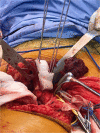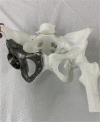Three-Dimensional Printing in Orthopedics: from the Basics to Surgical Applications
- PMID: 33409834
- PMCID: PMC7930137
- DOI: 10.1007/s12178-020-09691-3
Three-Dimensional Printing in Orthopedics: from the Basics to Surgical Applications
Abstract
Purpose of review: Additive manufacturing (AM) is a rapidly evolving field traditionally utilized in non-medical industries. Recently, the medical use of AM is expanding, especially in orthopedics. The goal of this article is presenting the principles of AM and its main applications in orthopedics.
Recent findings: The main indications for AM in orthopedics are education, orthotics, surgical planning, surgical guides, and custom-made implants. Three-dimensional (3D) digital models can be obtained from tomographic scans using available free software. Then, it can be used to create a physical model, plan surgeries, or develop surgical guides which can aid the orthopedic surgeon during complex cases. Recent studies demonstrated the benefits of using printed models in educating patients and medical residents. Custom-made implants also have been evaluated with promising clinical outcomes. Using 3D technology has become a reality in orthopedics. Surgeons should expect exponential growth of its applications in the upcoming years. It is paramount that orthopedists get familiar with this disruptive technology.
Keywords: Anatomic models; Orthopedics; Surgery; Surgical guides; Three-dimensional models; Three-dimensional printing.
Conflict of interest statement
The authors declare no conflict of interests.
Figures




Similar articles
-
3D-printed patient-specific applications in orthopedics.Orthop Res Rev. 2016 Oct 14;8:57-66. doi: 10.2147/ORR.S99614. eCollection 2016. Orthop Res Rev. 2016. PMID: 30774470 Free PMC article. Review.
-
Medical 3D Printing Cost-Savings in Orthopedic and Maxillofacial Surgery: Cost Analysis of Operating Room Time Saved with 3D Printed Anatomic Models and Surgical Guides.Acad Radiol. 2020 Aug;27(8):1103-1113. doi: 10.1016/j.acra.2019.08.011. Epub 2019 Sep 18. Acad Radiol. 2020. PMID: 31542197 Free PMC article.
-
3D printing metal implants in orthopedic surgery: Methods, applications and future prospects.J Orthop Translat. 2023 Sep 1;42:94-112. doi: 10.1016/j.jot.2023.08.004. eCollection 2023 Sep. J Orthop Translat. 2023. PMID: 37675040 Free PMC article. Review.
-
An overview of 3D printing and the orthopaedic application of patient-specific models in malunion surgery.Injury. 2022 Mar;53(3):977-983. doi: 10.1016/j.injury.2021.11.019. Epub 2021 Nov 18. Injury. 2022. PMID: 34838259 Review.
-
Three-dimensional printing in spine surgery: a review of current applications.Spine J. 2020 Jun;20(6):833-846. doi: 10.1016/j.spinee.2019.11.004. Epub 2019 Nov 13. Spine J. 2020. PMID: 31731009 Review.
Cited by
-
Impact of 3D-Printed Anatomical Models on Doctor-Patient Communication in Orthopedic Consultations: A Randomized Clinical Trial.Cureus. 2024 Oct 4;16(10):e70822. doi: 10.7759/cureus.70822. eCollection 2024 Oct. Cureus. 2024. PMID: 39493008 Free PMC article.
-
3D printing technology combined with personalized plates for complex distal intra-articular fractures of the trimalleolar ankle.Sci Rep. 2023 Dec 19;13(1):22667. doi: 10.1038/s41598-023-49515-1. Sci Rep. 2023. PMID: 38114629 Free PMC article. Clinical Trial.
-
Point-of-Care Orthopedic Oncology Device Development.Curr Oncol. 2023 Dec 29;31(1):211-228. doi: 10.3390/curroncol31010014. Curr Oncol. 2023. PMID: 38248099 Free PMC article.
-
3D-Printed Patient-Customized Artificial Vertebral Body for Spinal Reconstruction after Total En Bloc Spondylectomy of Complex Multi-Level Spinal Tumors.Int J Bioprint. 2022 May 31;8(3):576. doi: 10.18063/ijb.v8i3.576. eCollection 2022. Int J Bioprint. 2022. PMID: 36105139 Free PMC article.
-
Systematization of Steps for Printing 3D Models of Orthopedic Deformities.Rev Bras Ortop (Sao Paulo). 2022 Jun 6;59(4):e626-e631. doi: 10.1055/s-0042-1748816. eCollection 2024 Aug. Rev Bras Ortop (Sao Paulo). 2022. PMID: 39239589 Free PMC article.
References
-
- Whitaker M. The history of 3D printing in healthcare. The Bulletin of the Royal College of Surgeons of England. Royal College of Surgeons; 2014;96:228–9.
-
- Sarcar MMM, Mallikarjuna Rao K, Lalit NK. Computer aided design and manufacturing: PHI Learning Pvt. Ltd.; 2008.
Publication types
LinkOut - more resources
Full Text Sources
Other Literature Sources
Research Materials

